Discussion
Home ‣ Digital Electronics ‣ Number Systems and Codes See What Others Are Saying!
- Question
A binary number can be converted to a decimal number by summing the decimal values of the weights of all the 1s in the binary number.
Options- A. True
- B. False
- Correct Answer
- True
- 1. The noise immunity of a logic circuit refers to the circuit's ability to tolerate noise by causing spurious charges in the output voltage.
Options- A. True
- B. False Discuss
- 2. The main advantage of bipolar (TTL) memories over MOS memories is speed.
Options- A. True
- B. False Discuss
- 3. A very critical dimension in project management is ________.
Options- A. cost
- B. skill
- C. time
- D. personnel Discuss
- 4. A counter-ramp ADC stops counting when ________.
Options- A. the input voltage equals the DAC staircase voltage
- B. the counter reaches a maximum count
- C. the input voltage equals 5 volts
- D. the DAC staircase voltage equals 5 volts Discuss
- 5. With regard to a D latch, ________.
Options- A. the Q output follows the D input when EN is LOW
- B. the Q output is opposite the D input when EN is LOW
- C. the Q output follows the D input when EN is HIGH
- D. the Q output is HIGH regardless of EN's input state Discuss
- 6. The device shown in the given figure is checked with a logic probe and the output is HIGH.
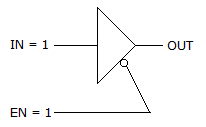
Options- A. The device is working properly.
- B. For the input conditions shown the output should be LOW; the input is shorted to ground.
- C. For the input conditions shown the output should be neither HIGH nor LOW; the device is shorted to
 .
. - D. The device is probably alright; the problem is most likely caused by the stage connected to the output of the device. Discuss
- 7. What is the current in R1 and the current in R2 for the circuit shown below?
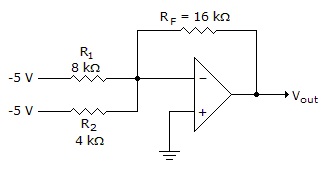
Options- A. I1 = 0.416 mA, I2 = 0.416 mA
- B. I1 = 0.357 mA, I2 = 0.357 mA
- C. I1 = 1.25 mA, I2 = 0.625 mA
- D. I1 = 0.625 mA, I2 = 1.25 mA Discuss
- 8. Referring to the given figure, what should the display on the scope look like if the A/D converter is working properly?
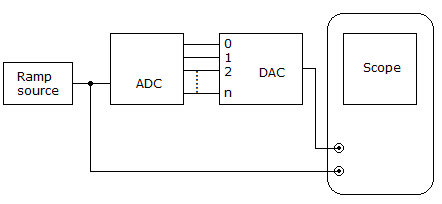
Options- A. It should be a circular Lissajous pattern resulting from the simultaneous application of ramps to the vertical and horizontal inputs of the oscilloscope.
- B. The pattern should be a straight line across the screen due to the equal but opposite voltages being applied to the scope inputs.
- C. A uniform stairstep pattern should be displayed.
- D. The scope should display a sequential binary count with the LSB on the left and the MSB on the right side of the display. Discuss
- 9. Referring to the given figure, what appears to be wrong, if anything, with the output of the D/A converter?
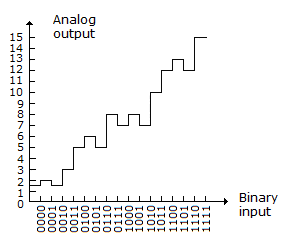
Options- A. The input signal is probably noisy.
- B. There appears to be some nonlinearity in the scope display.
- C. The converter has a nonmonotonic output error.
- D. It appears that certain input codes are incorrect; double-check the input coding. Discuss
- 10. What is the output voltage of the given circuit if the inputs are as follows:
20 = 1, 21 = 1, 22 = 0, 23 = 0?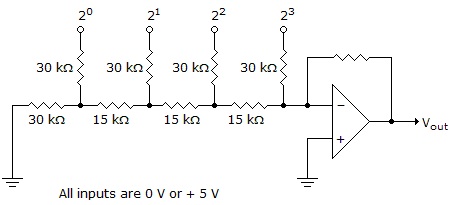
Options- A. ?3.115 volts
- B. ?2.8025 volts
- C. ?1.875 volts
- D. ?1.24 volts Discuss
More questions
Correct Answer: False
Correct Answer: False
Correct Answer: time
Correct Answer: the input voltage equals the DAC staircase voltage
Correct Answer: the Q output follows the D input when EN is HIGH
Correct Answer: For the input conditions shown the output should be neither HIGH nor LOW; the device is shorted to
 .
. Correct Answer: I1 = 0.625 mA, I2 = 1.25 mA
Correct Answer: A uniform stairstep pattern should be displayed.
Correct Answer: The converter has a nonmonotonic output error.
Correct Answer: ?1.875 volts
Comments
There are no comments.More in Digital Electronics:
Programming
Copyright ©CuriousTab. All rights reserved.
